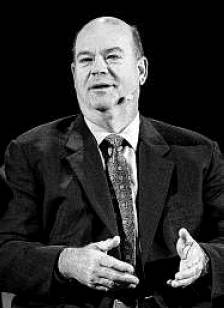Houston oil CEOs differ on future of output
By Paul Takahashi STAFF WRITER
The chief executives of the nation’s two largest independent oil companies disagree on whether U.S. crude production will return to the record level before the pandemic-driven oil crash.
Vicki Hollub, CEO of Houston-based Occidental Petroleum, and Ryan Lance, CEO of Houston-based ConocoPhillips, laid out different expectations for the nation’s future oil production Monday during back-to-back talks at Argus Media’s crude oil summit in downtown Houston.
U.S. crude output peaked at 13 million barrels per day in February 2020, before pandemic-related economic lockdowns and travel restrictions nearly erased crude demand and sent prices to a record low. Production has recovered to about 11.7 million barrels per day, but as the world shifts from fossil fuels, future demand and production remains in question.
“I don’t think we’ll ever get to that level,” Hollub said. “I do think we’ll get over 12 million (barrels per day) going into next year … but probably not to the 13 (million).”
“Yeah, we will,” Lance said less than an hour later. “Some are saying no way, but we will.”
As oil companies recover from the pandemic and face an existential threat posed by climate change, the industry remains split on whether oil production has peaked already or will do so in the coming decades.
Oxy, which has ambitions to become a leading carbon management company, has invested heavily in carbon-capture technology over the past couple of years, including developing its first direct-air carbon-capture facility in the Permian Basin of West Texas. The company was the first U.S. oil company to set net-zero targets for its operations and its customers’ emissions, and it aims to become a net-zero emissions company by 2040.
Conoco, on the other hand, still believes U.S. production will continue to grow for decades as the world’s expanding population remains reliant on crude and natural gas for energy. The company, which has ambitions to achieve net-zero emissions by 2050, has spent $20 billion in the past two years to acquire Concho Resources and Shell’s Permian assets to become the second-largest shale producer in the nation’s most prolific oil field.
Hollub on Monday said she believes the U.S. shale industry will continue to rebound and grow, especially in the DJ Basin of Colorado, the Eagle Ford of South Texas and the Bakken of North Dakota. The Permian Basin of West Texas and New Mexico has already recovered to pre-pandemic levels, producing around 5 million barrels of crude per day. Hollub said, however, that she doesn’t expect drilling activity in oil fields outside of the Permian to return to pre-pandemic levels.
That’s in large part, Hollub said, because oil companies have become more efficient at producing oil with fewer rigs.
“I don’t think any of those basins necessarily will achieve the peak that they had previously,” Hollub said. “We’re not only drilling faster, we’re getting more out of every well we drill than we did a few years ago.”
Lance, however, said most petroleum economists expect global oil demand is going to continue to rise in the near future, perhaps peaking between 2030 and 2040 before starting a slow decline. Even with declining demand for crude and natural gas, the energy industry will still require billions of dollars of investment to continue to supply the world with fossil fuels, he said.
“The industry is probably investing at half that pace when you consider (what) needs to be invested over the next 10 to 20 years,” Lance said.
Despite their differences of opinion on the direction of U.S. oil production, Hollub and Lance agreed that the oil industry will need to work with governments, industry, investors and even environmental groups to cut carbon emissions to keep producing oil and gas at whatever level the world demands. They decried last fall’s COP26 United Nations climate conference in Glasgow, Scotland, where leaders ramped up emissions targets but left without concrete plans on how to meet them.
“Not a single oil company sat in any of the official meetings at COP26 — we were not invited,” Hollub said. “And without the oil and gas industry, there’s no way that addressing climate change will ever be successful.”
Lance, in particular, warned that a quick and disruptive energy transition where oil and gas investment and production falls well before demand lets up could leave the world paying higher energy prices. The amount of oil and natural gas discovered globally last year fell to the lowest level in 75 years after oil companies slashed their exploration budgets during the pandemic downturn.
“There’s an orderly way to go about this (energy transition) if you choose to go do it,” Lance said. “Unfortunately, I think most of the dialogue and the consequence coming out of COP26, including where this (Biden) administration wants to go, is a cliff transition, and there’s nothing right or just about that.” paul.takahashi@chron.com twitter.com/paultakahashi

